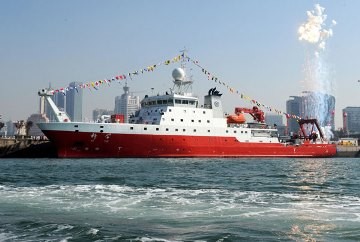China has completed building an observation network supported by submerged buoys in the Western Pacific, seen as an essential component for its continuous maritime observation, the Xinhua News Agency reported.
The announcement was made following the return of Kexue (Science) to the eastern port city of Qingdao on Sunday, Nov. 15, after the conclusion of a 77-day expedition covering 11,000 nautical miles.
According to the Institute of Oceanology under the Chinese Academy of Sciences, the research ship has recovered 15 sets of deep-sea buoys in the Western Pacific and retrieved more than 380 pieces of observation equipment.
Kexue, the country's most sophisticated research vessel, weighs 4,711 tonnes and measures 99.8 meters long and 17.8 meters wide. It has a cruising capacity of 15,000 nautical miles with a top speed of 15 knots.
Wang Fan, the voyage's chief scientist, said that they have placed another 13 sets of submerged buoys and more than 350 pieces of observation equipment in the area.
"With the retrieved buoys, we have obtained valuable scientific statistics about ocean temperature, salinity and circulation for a year over the tropical West Pacific," Wang said. He added that the data collected from the system will help scientists better understand the relationship between the ocean currents in the Western Pacific and China's climate change.
Wang said that the successful recovery of the buoys signifies that China "has built its own observation network for scientific research over the tropical West Pacific."
The large-scale installation of submerged buoys in the Western Pacific Ocean was undertaken by China for the first time in October last year.



























